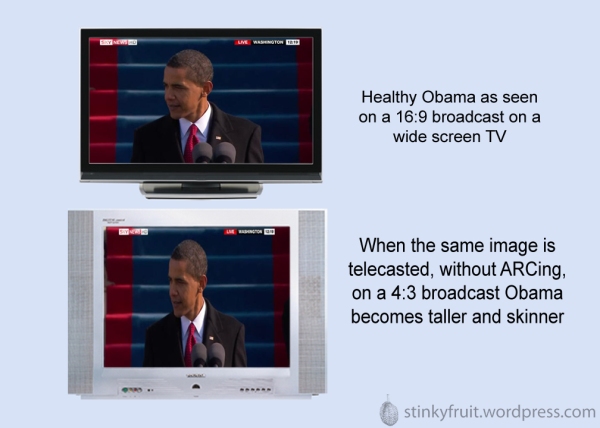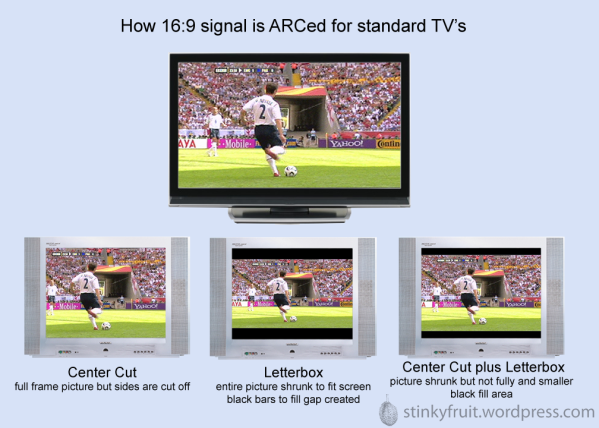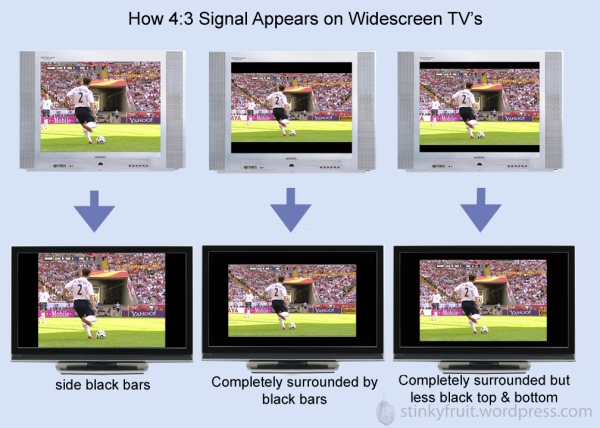Here’s the dilemma, not all TV broadcaster actually broadcast a wide screen image, many are still only broadcasting a picture compatible to the standard TV screen size. So what happens when these guys buy a new programme or receive a satellite feed that is full wide screen. How do they get it ready for broadcast, what do they do and why?
They ARC it. ARC stands for Aspect Ratio Conversion and aspect ratio is the width to height ratio of a TV. Your standard TV set is 4:3 and a wide screen TV is 16:9. If they simply broadcast the image with out ARCing first it will distort the image and it looks dreadful, everything becomes tall and thin.

Most broadcasters choose one of 3 ARCing options. All have pros and cons. Here are the 3 choices
1. Center Cut
The sides are removed and only the center image is shown.
Pros: Full frame Picture and the most commonly used method.
Cons: If the content is not made specifically for TV then titles and parts of the action could fall off the sides of the screen. All programmes made for TV have a center area called the “4:3 safe zone”. This zone is an area where all essential action and graphics must sit regardless if it is a wide screen production or not. This safe zone is used specifically so that when a programme is center cut only non essential image is lost
Movies almost always are shot in a wider then 16:9 aspect ratio and many do not follow a safe zone (although it is becoming increasingly common for them to do so now-a-days as the DVD market is still strong) so when they are ARCed during the transfer to tape or file sometimes a method called “pan and scan” is used. Pan and scan is rarely performed by the broadcaster but instead by the production house doing the transfer so I won’t go over that. Google it for more info.
2. Letterbox
Shrinks the entire 16:9 image down and aligns the image in the middle of the 4:3 screen.
Pros: None of the original image is lost.
Cons: Black bars on the top and bottom of the screen and a smaller picture.
3. Center Cut + Letterbox
A bit of both, designed to allow a wider graphic safe zone during the production of the programme but has major issue when the content is sold on to another broadcaster.
Pros: A wider picture image is shown and it has a wider graphic safe zone
Cons: Black bars on the top and bottom of the screen and a smaller picture but not as small as 100% letterboxing.
It is a nice compromise at first thought but the major draw back is that the programme can never be broadcast on a 4:3 signal without ever seeing black bars on the screen. That is amazingly silly thing to do! Why limit that possibility? Why in this day and age must we ever see black bars, no matter how small they are, on a 4:3 TV screen? The only time in the past this has ever happened is when watching a western movie filmed in panovision, it makes no sense that it happens on made for TV programmes.

S0 what happens when you watch this 4:3 broadcast on a wide-screen TV?
When a wide-screen TV is set correctly to receive a 4:3 broadcast there will always be black bars down the side of screen. This is called the Pillar Box

So unless the signal is a center cut you will have black bars all around the image. This is known as a “postage stamp” effect. It is a waste of TV screen space. Of course the viewer can change their TV to stretch or fill the image to full screen.












Pingback: Astro B.yond: v1.1s preview « Stinkyfruit's Blog